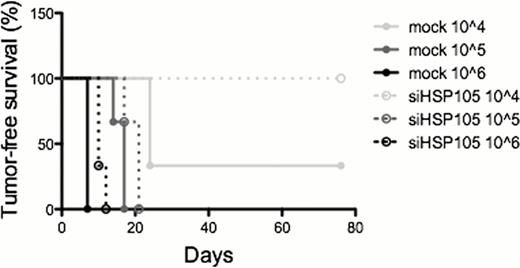Abstract
Abstract 1562
Our previous findings have made it clear that the significant clinical efficacy attained by dendritic cell-based vaccination in relapsed B-cell non-Hodgkin lymphoma (B-NHL) patients is firmly associated with multifaceted immunologic responses, including the development of anti-heat shock protein (HSP)105 humoral immunity (Di Nicola et al., Blood 2009 113:18–27; Zappasodi et al., Cancer Res. 2010 70:9062–9072; Zappasodi et al., Blood 2011 118:4421–4430). Human HSP105 is a high-molecular-weight chaperone constitutively expressed at low levels within the cytoplasm, and can also be induced in the nucleus by various forms of stress. It is overexpressed in several solid tumors, including melanoma, breast, thyroid and gastroenteric cancers. We have recently shown that this is also true for B-NHLs, in which HSP105 levels increase in function of their aggressiveness and proliferation index (Zappasodi et al., Blood 2011 118:4421–4430). Accordingly, in normal lymph nodes HSP105 expression is confined to the hyper-proliferating germinal center (GC) B cells, suggesting its involvement in the potentially oncogenic GC reactions.
We have now set out to clarify the functional role of HSP105 in B-NHLs by stably silencing its expression in the Namalwa aggressive lymphoma cell line. Namalwa cells were infected by using a lentiviral vector carrying a HSP105-targeting pre-microRNA sequence and the Emerald Green Fluorescent Protein (EmGFP) gene, both under the human cytomegolovirus immediate early promoter, as well as the blasticidin resistance gene. Control cells were mock-infected with the empty vector. Infected cells were initially selected in the presence of blasticidin, and then single GFP+ cells were sorted on a flow cytometry device. In this way, we achieved 100% GFP+ subclones that displayed a specific constitutive down-regulation of HSP105, as there was no significant decrease in the expression of its cognate molecular homolog HSP70, or the other major cellular chaperone HSP90. Comparison of the in vitro proliferation rate of two silenced clones with that of the mock culture showed that the cell doubling time of both clones significantly increased and their in vitro growth was accordingly delayed (P= 0.01 and P= 0.04). Western blot analysis in 6 different silenced clones of the oncoproteins most frequently involved in B-NHLs revealed that BCL-6 and c-Myc were down-regulated in function of HSP105 knockdown levels, whereas in mock cells no modifications were detected with respect to their wild-type counterparts. Further strengthening the association between HSP105, BCL-6 and c-Myc expression, immunohistochemistry analysis of 50 primary human aggressive B-NHLs revealed that HSP105 expression, measured both as intensity and percentage of positive cells, was significantly higher in c-Myc- or BCL-6-dependent Burkitt (P= 0.0264) and diffuse large B-cell lymphomas (P= 0.0068) respectively than in other aggressive istotypes that do not overexpress these oncoproteins. These findings support the potential pro-tumorigenic cooperation of HSP105 with BCL-6 and c-Myc transcription factors. To find out whether counteracting HSP105 functions hampers in vivo lymphoma growth, we evaluated the tumor-forming capability of HSP105-silenced (siHSP105) or mock Namalwa cells subcutaneously injected into severe combined immunodeficient mice at serial 10-fold dilutions from 106 to 104 cells/injection (Figure 1). We found that HSP105 knockdown slightly delayed in vivo Namalwa tumor formation when 106 and 105 cells were injected. Noteworthy, no lesions appeared over 70-day observation in mice inoculated with 104 siHSP105 cells, whereas palpable tumors were present in 67% of the animals 24 days after injection of the mock cells (Figure 1).
Overall, these results indicate that HSP105 may be a per se nononcogenic molecule that contributes to lymphomagenesis by facilitating the tumorigenic functions of key oncoproteins. They equally provide the rationale for developing HSP105 inhibitors as a novel strategy for improving the treatment of aggressive B-NHLs.
Gianni:Hoffmann-La Roche: Consultancy, Honoraria.
Author notes
Asterisk with author names denotes non-ASH members.


